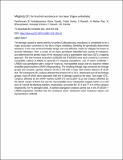| dc.contributor.author | Venkataramana, Pavithravani | |
| dc.contributor.author | Gowda, Rame | |
| dc.contributor.author | Somta, Prakit | |
| dc.contributor.author | Ramesh, S | |
| dc.contributor.author | Rao, Mohan | |
| dc.contributor.author | Bhanuprakash, K | |
| dc.contributor.author | Srinives, Peerasak | |
| dc.contributor.author | Gireesh, C | |
| dc.contributor.author | Pramila, CK | |
| dc.date.accessioned | 2023-10-17T09:08:14Z | |
| dc.date.available | 2023-10-17T09:08:14Z | |
| dc.date.issued | 2016-06 | |
| dc.identifier.uri | https://doi.org/10.1007/s10681-015-1551-8 | |
| dc.identifier.uri | https://dspace.nm-aist.ac.tz/handle/20.500.12479/2322 | |
| dc.description | This research articles was published in Euphytica journal, volume 207, 2016 | en_US |
| dc.description.abstract | The damage caused to stored seed by bruchids (Callosobruchus maculatus) is considered to be a major production constraint in rice bean (Vigna umbellata). Breeding for genetically determined resistance is the most environmentally benign and cost-effective means to mitigate the losses to bruchid infestation. Here, a screen of rice bean germplasm identified two sources of resistance, and determined the genetic basis of the resistance using a quantitative trait locus (QTL) mapping approach. The two resistant accessions (LRB238 and JP100304) were each crossed to a common susceptible cultivar (LRB26) to generate F2 mapping populations, one of which (LRB238 × LRB26) was genotyped with a range of Vigna sp. microsatellite assays and by sequence related amplified polymorphism (SRAP) fingerprinting. The resulting linkage map comprised ten linkage groups and covered a genetic distance of 872.1 cM with a mean inter-marker distance of 32.05 cM. The subsequent QTL analysis detected the presence of 11 QTL, distributed over all ten linkage groups, most of which were associated with the % damage caused to the seed. Two major QTL, Cmpd1.5 (flanked by the SRAP markers E2M9-270 and E12M7-311) and Cmpd1.6 (flanked by the SRAP marker E7M10-141 and the microsatellite locus CEDG259) mapped within 11.9 cM and 13.0 cM of the flanking markers, respectively, accounted for, 67.3 and 77.4 % of the variance respectively, for % damaged seeds. A bulked segregation analysis carried out in the JP100304 × LRB26 population revealed that the resistance donor harboured some resistance factors not represented in LRB238. | en_US |
| dc.language.iso | en | en_US |
| dc.publisher | Springer Netherlands | en_US |
| dc.subject | Research Subject Categories::FORESTRY, AGRICULTURAL SCIENCES and LANDSCAPE PLANNING | en_US |
| dc.title | Mapping QTL for bruchid resistance in rice bean (Vigna umbellata) | en_US |
| dc.type | Article | en_US |

